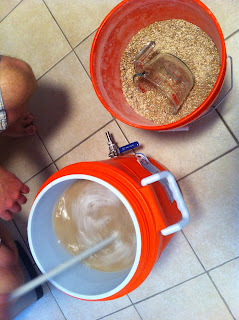I don't know about you, but when I think about kegs, I think of college frat parties, handstands, foamy beer and of course...eggs
Now that I'm a part of this homebrewing adventure...I think of CO2 tanks, ball vs. pin locks, pressure regulators and "corneys"
It'll all make sense to you in a minute too...
As much fun as it has been to bottle our own beer, and give 6 packs away for the holidays, bottling, as many homebrewers will tell you, is actually a huge pain in the ass. Especially after you learn the glory that is kegging.
Why Keg?
1) Easier to clean/sanitize 1 keg vs. 50 bottles
2) Force carbonation allows for carbonation adjustments to your brew
3) Kegs last forever
4) Impress your friends
You only have to sanitize one big unit instead of 50 individual bottles?! Yea...I'll do that
So what does kegging consist of? Usually a system is made up of a keg (although let's be honest, you're going to want/need more than one...we have 3), a CO2 (carbon dioxide) gas tank, a pressure regulator and two hoses per keg. One hose feeds CO2 gas into your keg inlet, and the other hose brings the beer from the keg to your tap.
Keg sizes vary, but the most popular size is the 5 gallon Cornelius or “Corney” keg. (Starting to come together now?)
The first step in order to keg your homebrew is to pressurize and sterilize the keg. You need to make sure there are no leaks and you will be able to achieve an air tight seal.
Then, fill the keg by siphoning in your homebrew. Once full, put the top on it and pressurize the keg using your CO2 tank. Purge any remaining air in the keg and displace it with CO2.
To determine the amount of CO2 needed for your beer, we use our good ol' friend math (OR this handy dandy (no really...it's called that) Carbonation Chart) Carbonation levels vary by beer but you'll need the refrigerator temperature and volume of beer to determine the level used. Set your CO2 tank regulator to the desired pressure, hook it to your keg and place the keg in the refrigerator. It is better to start with a lower carbonation and tweak your beer up to a higher one if desired, rather than the other way around.
For storage/chilling, we bought a chest freezer from Costco that will eventually be fitted with a collar and taps...but one step at a time.
This:
Will eventually look something like this:
The important thing to remember when it comes to kegging beer is to make sure you are leak free and that everything is sanitized.
The best part about kegging (other than offering your friends beer from it)? Kegged beer will begin to carbonate in a day or two and reach full carbonation within a week! That's at least 2 weeks shorter than bottling!!
#winning
The beer is tasty, maintains a nice foamy head, and is just overall awesome! I'm a convert!

















































